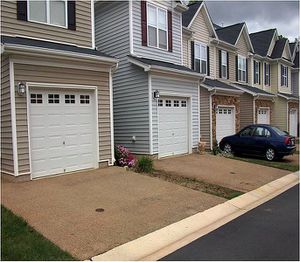
Difference between revisions of "Permeable pavement"
m |
m |
||
| Line 10: | Line 10: | ||
| − | '''The individual articles comprising this section on permeable pavement may be viewed as a [[permeable pavement combined|single article]].''' | + | '''The individual articles comprising this section on permeable pavement may be viewed as a [[permeable pavement combined|single article]].''' Note: Due to an unresolved bug, when viewing a formula in a combined article, the math markup (used for equations) is displayed. Please ignore the markup. Thanks. |
Revision as of 16:41, 6 May 2013
The anticipated review period for this page is January through May, 2013
Permeable pavements allow stormwater runoff to filter through surface voids into an underlying stone reservoir for temporary storage and/or infiltration. The most commonly used permeable pavement surfaces are pervious concrete, porous asphalt, and permeable interlocking concrete pavers (PICP). Permeable pavements have been used for areas with light traffic at commercial and residential sites to replace traditional impervious surfaces in low-speed roads, alleys, parking lots, driveways, sidewalks, plazas, and patios. While permeable pavements can withstand truck loads, permeable pavement has not been proven in areas exposed to high repetitions of trucks or in high speed areas because its’ structural performance and surface stability have not yet been consistently demonstrated in such applications.
While design details vary, all permeable pavements have a similar structure, consisting of a surface pavement layer, an underlying stone aggregate reservoir layer, optional underdrains and geotextile over uncompacted soil subgrade. From a hydrologic perspective, permeable pavement is typically designed to manage rainfall landing directly on the permeable pavement surface. Permeable pavement surfaces may accept runoff contributed by adjacent impervious areas such as driving lanes or rooftops. The capacity of the underlying reservoir limits the contributing area. Runoff from adjacent vegetated areas must be stabilized and not generating sediment as its transport accelerates permeable pavement surface clogging.
The individual articles comprising this section on permeable pavement may be viewed as a single article. Note: Due to an unresolved bug, when viewing a formula in a combined article, the math markup (used for equations) is displayed. Please ignore the markup. Thanks.
Permeable pavement articles
- Overview for permeable pavement
- Types of permeable pavement
- Design criteria for permeable pavement
- Construction specifications for permeable pavement
- Assessing the performance of permeable pavement
- Operation and maintenance of permeable pavement
- Calculating credits for permeable pavement
- Additional considerations for permeable pavement
- References for permeable pavement
Several fact sheets for permeable pavement provide overview information and information on design, construction and maintenance, and volume and pollutant removal.
